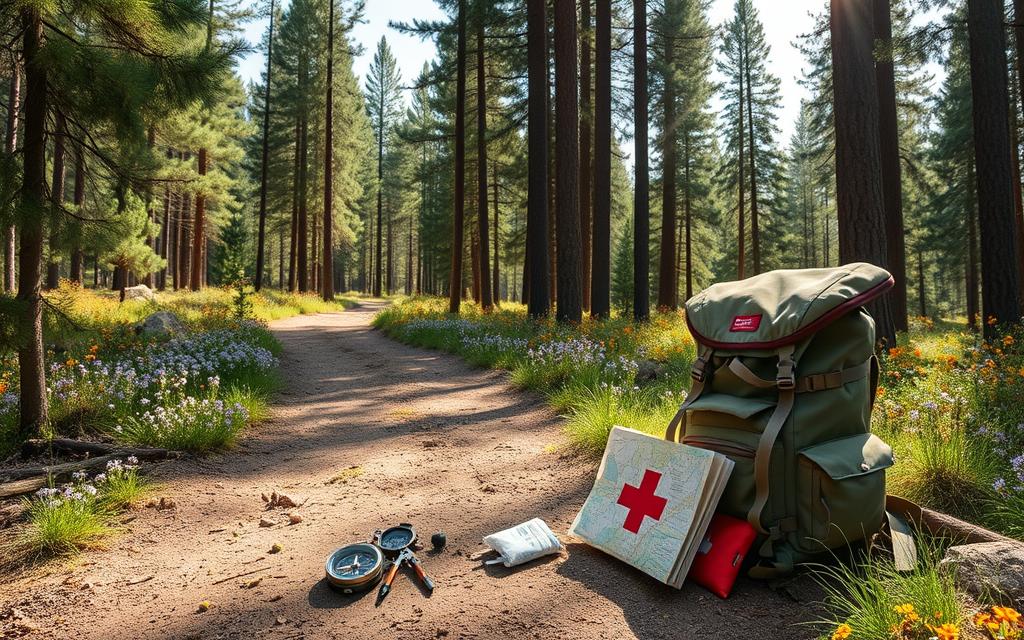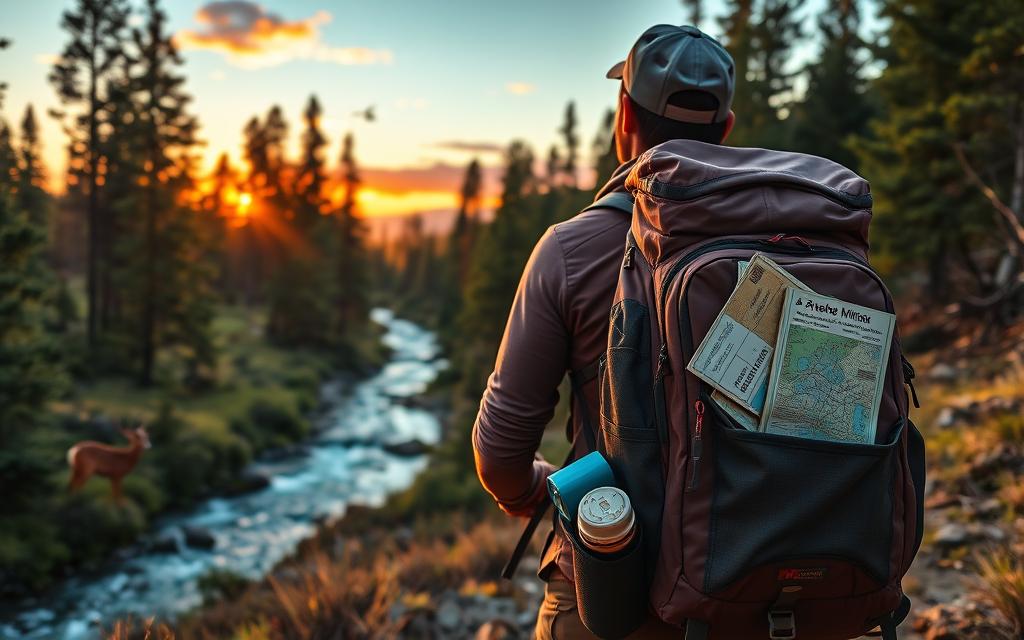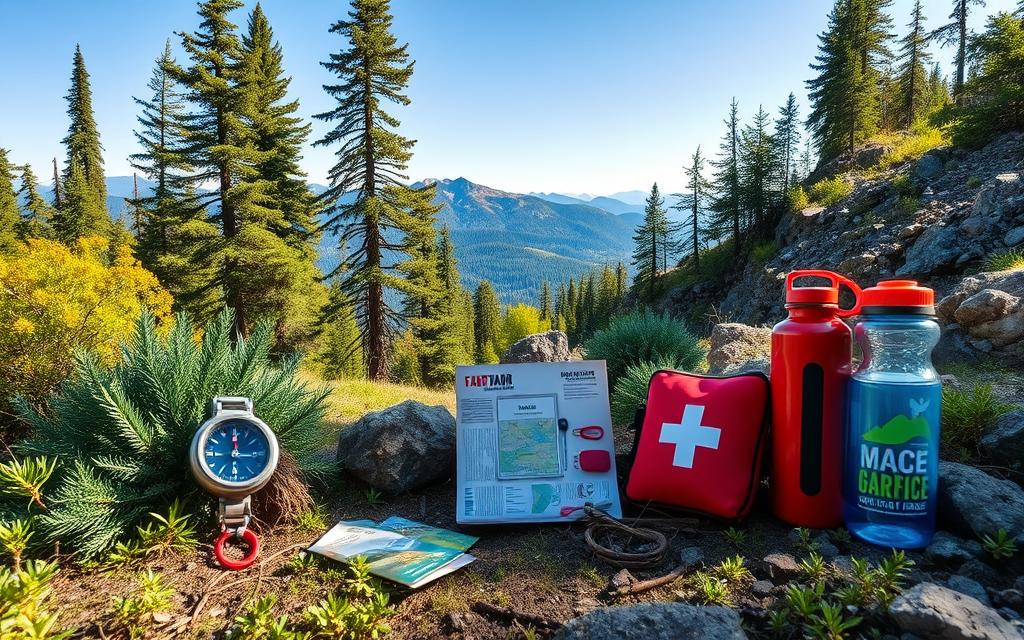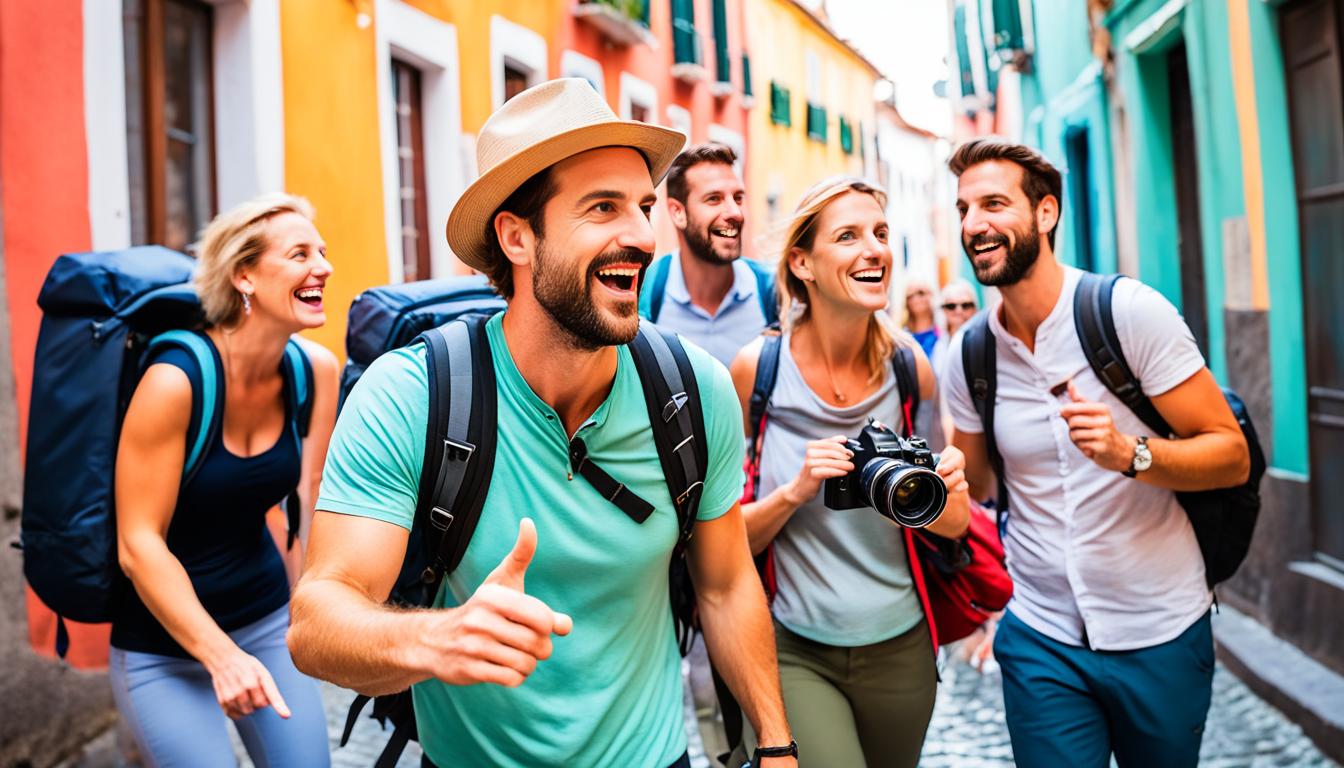Going on an outdoor adventure is exciting and rewarding. But, it’s important to think about safety first. About 78% of outdoor lovers worry about their safety in nature. They face dangers like extreme weather, injuries, animal encounters, and getting lost.
Before you head out, check the weather at your destination. Look for any risks or conditions that could affect your safety. It’s also key to pack the right safety gear, like the ten essentials, bear spray, and a first aid kit.
Wearing the right clothes for the weather and season is important. It helps keep you safe and comfortable outside.
Learning basic first aid and telling someone your plans are vital. Being aware of your surroundings is also crucial. Knowing how to fix important gear and having a safety plan are big helps, especially in groups.
Be honest about your physical limits and the challenges you’ll face. Always listen to your gut when it comes to staying safe.
Understanding the Importance of Wilderness Safety
Going into the great outdoors is exciting and rewarding. But, it also has risks. Outdoor lovers must put safety first to make their adventures fun and memorable. Knowing the dangers and taking steps to avoid them is crucial for a safe trip.
Why Safety Matters in the Outdoors
The wilderness is full of challenges that can harm even the most seasoned adventurers. Extreme weather and dangerous animals are just a few of the risks. Being prepared and cautious is key to staying safe and enjoying the wilderness.
Potential Hazards You Might Encounter
- Extreme weather, including heat, cold, lightning, storms, floods, and hurricanes
- Encounters with wildlife, such as snake bites, bear attacks, insect bites, and stings
- Accidents and injuries, including fractures, cuts, sprains, and dislocations
- Environmental factors like hypothermia, dehydration, and altitude sickness
- Navigation errors, such as getting lost or separated from the group
Knowing about these dangers and taking precautions can make outdoor adventures safer. Being well-prepared, equipped, and knowledgeable is essential for a safe and enjoyable trip.
“Wilderness safety is not just a recommendation, it’s an essential component of any outdoor adventure. By prioritizing safety, we can unlock the true beauty and wonder of the great outdoors.”
Essential Gear for Wilderness Adventures
Going on a wilderness adventure means you need to plan and pack the right gear. This includes survival tools, the right clothes, and a first aid kit. The right equipment is key to staying safe and ready for anything outdoors.
Must-Have Survival Tools
Outdoor experts know the value of the right survival tools. You’ll need a good map and compass, a strong flashlight or headlamp, and a knife or multitool. Don’t forget a fire starter and a way to signal for help if needed. A tough backpack and water filter are also crucial.
Clothing and Footwear Considerations
Wearing the right clothes is important for comfort and safety. Choose clothes that breathe and protect you from the weather. It’s smart to wear layers and have a rain jacket or poncho ready. Good hiking boots or shoes with traction are essential for uneven paths.
First Aid Kit Essentials
A good first aid kit is a must-have. It should have bandages, antiseptic, pain relievers, and any meds you need. Add splints, tourniquets, and emergency blankets for more serious injuries. The My Medic Myfak Pro or Tacticon Armament IFAK V2 Standard are great choices for wilderness adventures.
With the right gear, you’ll be safer and better prepared for wilderness adventures. Stay hydrated, protect from the sun, and have the tools you need for emergencies.

| Gear Item | Recommendation | Key Features |
|---|---|---|
| Backpack | Durable, water-resistant, and comfortable | Padded shoulder straps, multiple compartments, and a sturdy frame |
| Flashlight/Headlamp | Bright, reliable, and rechargeable | Long battery life, adjustable beam, and waterproof housing |
| First Aid Kit | Comprehensive, wilderness-specific | Includes bandages, antiseptics, medications, and emergency supplies |
| Clothing | Moisture-wicking, insulating, and weatherproof | Layered system with base, mid, and outer layers |
| Footwear | Sturdy, supportive, and traction-oriented | Ankle support, lugged soles, and breathable materials |
“By being prepared with the right gear, you can focus on enjoying the beauty and adventure of the wilderness, rather than worrying about your safety.”
Planning Your Wilderness Experience
Planning is key for a safe and fun backcountry trip. Before you go, do your homework on the place you’re visiting. Learn about the terrain, wildlife, and dangers you might face. Also, check the weather from different sources to plan better.
Researching Your Destination
First, learn about your destination. Know the geography, elevation, and any special features. Look out for risks like steep slopes or dense forests. Also, find out about local wildlife to stay safe.
Checking Weather Conditions
Weather in the backcountry can change fast. Look at several weather forecasts to understand what you might face. This helps you pack right and plan your trip, like changing your route if it rains.
Informing Someone About Your Trip
Before you leave, make a detailed plan and share it with someone you trust. Include your route, when you’ll arrive, and any important stops. This way, they can help if you’re late or need help.
By researching, checking the weather, and telling someone your plans, you’re more likely to have a safe and great trip. Remember, following backcountry safety guidelines and outdoor adventure planning are crucial for a good time outdoors.

“Failing to plan is planning to fail. Proper preparation prevents poor performance.”
Navigating Through the Wilderness
Learning wilderness navigation is key for outdoor lovers. It ensures safe and fun adventures. Whether you’re seasoned or new, knowing how to read maps, use compasses, and GPS is vital. It can mean the difference between a great trip and a risky one.
Map and Compass Skills
Get good at reading topographical maps and using a compass. Learn to take bearings, follow directions, and find your spot. These skills keep you on track and prevent getting lost.
Utilizing Technology for Safety
Technology is helpful outdoors, but don’t rely only on it. Carry a GPS, but also a map and compass as a backup. Know how to use your GPS to read coordinates, mark waypoints, and navigate.
Recognizing Landmarks and Trails
Learn to spot natural landmarks, terrain, and trails. Know the area you’ll explore and its features like peaks, rivers, and forests. Staying on trails helps avoid getting lost or facing dangers.
If lost, stay calm and use your skills to find your spot on a map. Use the sun, moon, and stars for direction. If lost, try to retrace your steps. Knowing how to navigate is key to outdoor safety and fun.
| Wilderness Navigation Techniques | Description |
|---|---|
| Map Reading | Familiarize yourself with reading topographical maps to understand terrain features, elevation, and trail systems. |
| Compass Use | Learn how to use a compass to take bearings, follow compass headings, and triangulate your position. |
| GPS Navigation | Utilize GPS devices to track your location, mark waypoints, and navigate through the wilderness, but always have a backup map and compass. |
| Landmark Identification | Develop the ability to recognize distinctive natural features, such as mountains, rivers, and forest types, to orient yourself. |
| Celestial Navigation | Use the sun, moon, and stars to determine direction and orientation if your other navigation tools are unavailable. |
“The wilderness is not a luxury but a necessity of the human spirit.” – Edward Abbey
Responding to Emergencies in the Wilderness
Being ready for emergencies is key when exploring the outdoors. Knowing basic first aid can help treat injuries like cuts, sprains, and blisters. It’s also vital to know how to handle serious issues like hypothermia, heat stroke, and altitude sickness.
First Aid Techniques
Learn essential first aid skills before you go. Understand how to clean and bandage wounds, and how to care for various wilderness injuries. Practicing with your first aid kit will make you more confident in emergency situations.
How to Signal for Help
If you face a serious emergency, it’s important to signal for help. Carry items like whistles, mirrors, or bright fabrics to attract attention. Also, make sure your technology, like a satellite phone or personal locator beacon, is charged and ready.
Creating a Safety Plan
Make a detailed safety plan before your adventure. Include emergency contacts, meeting points, and plans for different situations. Share this plan with your loved ones and practice emergency procedures to be better prepared.
Source Links
- https://www.thisbigwildworld.com/outdoor-adventure-safety-tips/
- https://www.idahomedicalacademy.com/10-outdoor-adventure-safety-tips/
- https://www.uhone.com/health-and-wellness/healthy-living/healthy-for-life-outdoor-adventure-safety
- https://crrhospitality.com/blog/outdoor-emergency-protocols-keeping-your-campsite-safe/
- https://noc.com/news/wilderness-survival-tips-for-families/
- https://parktrust.org/blog/10-essential-items-for-outdoor-adventures/
- https://bulletproofzone.com/blogs/bullet-proof-blog/wilderness-survival?srsltid=AfmBOoo2fECPf5xX8pRGYyQ7v8vYKxisYMF-E7dQ8JFpSr1WiLLButtA
- https://silentsportsmagazine.com/2021/01/28/a-guide-to-safe-effective-planning-for-trips-into-the-wilderness/
- https://getprepwell.com/blogs/the-prepwell-blog/wilderness-safety-guide-10-essential-tips-for-a-secure-camping-experience
- https://thekingsleyclinic.com/uncategorized/embracing-outdoors-safely-understanding-wilderness-first-aid/
- https://www.seattlechildrens.org/healthy-tides/wilderness-safety-tips-for-families/
- https://www.nps.gov/olym/planyourvisit/wilderness-safety.htm
- https://www.psglearning.com/blog/ecsi/2023/09/13/how-to-survive-a-wilderness-emergency?srsltid=AfmBOoozTUWE_zck59y_FnorY4DDI96rkikGe79CtmE_vKqtMsjJ6EjX
- https://www.princeton.edu/~oa/safety/emergency.html

